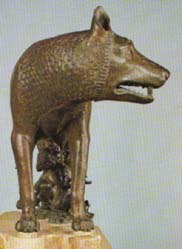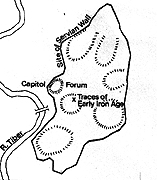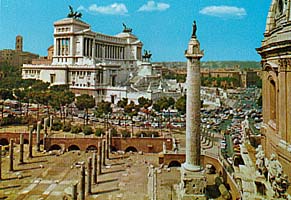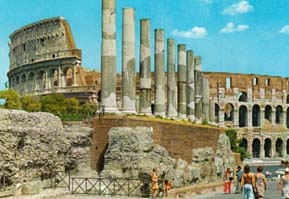

A SHORT HISTORY OF ROME
Revised December 22, 2002 ( MMII ) AD
Anno Domini - from the Year of the Lord
Year of Rome 2755 ( MMDCCLV ) AUC
Ab Urbe Condita - from the founding of the City - April 21, 753 BC


The famous "Capitoline She-Wolf" or "Lupa Capitolina", a bronze Etruscan sculpture dating to the 5th Century BC . From time immemorial, this sculpture has been the traditional Icon of Ancient Rome. The figures of the twins, Romulus and Remus, being suckled by the Wolf (lupus), were added by Antonio Pollaiuolo in the 15th Century. The combined statues now reside in the Palazzo dei Conservatori Museum, on the Capitoline (Capitol) Hill in Rome, Italy.
According to tradition, Rome was founded on April 21, 753
BC. The legend says that Romulus and Remus, the twins of the War God
"Mars", were cast adrift on the River Tiber and survived by being raised
by a she-wolf.
Romulus later, during a family feud, killed his brother Remus.
Romulus subsequently established the so-called Roma Quadrata, above the east
shore of the River Tiber, by carving its borders with a plow atop the Palatine
Hill. The Roma Quadrata was to become the city that bears his
name. Romulus was not only the founder of Rome, but also its first
King. The Palatine Hill was already inhabited, bearing traces of an
Early Iron Age settlement. The site was chosen, it is said,
because the River Tiber could be more easily crossed at that point.

The original layout for the City of Rome. Its location, having a history of habitation dating back to about 1000BC, was chosen because the River Tiber could be easily crossed at that point.
From this legendary beginning, Rome grew to become the most
important city in the ancient western world. The civilization that developed
became the most powerful empire of its time. At its height, it governed the
lives of 60 million people, one-fifth of the world's population; all of whom obeyed its
laws, paid taxes to its emperor, and were familiar with its language, religions and
customs. Rome was quite literally the Super Power of the Ancient World. The
City of Rome itself, in the 1st Century AD, with a population of over one
million, was the largest city on earth. Not until London, in the
year 1800, would another city reach a population density of one million.
Rome became dominated by the well established Etruscan civilization to the North, from 616
to 510 BC. The Romans adopted many elements of the Etruscan and Greek
cultures. Gladiator fights and chariot racing were Etruscan in origin.
Roman art, architecture and literature were heavily borrowed from the Greeks.
Although the Etruscans had much to offer, the Romans came to resent this
domination and in 509 BC, Rome's last Etruscan King was dethroned and the Roman Republic
was founded. It was ruled by two consuls, who were elected each year by the
Senate. From this the familiar logo of ancient Rome came into being
"S*P*Q*R"... "Senatus Populusque Quiritum Romanorum", meaning
the "Senate and People of Rome".
In 390 BC, the City of Rome was attacked and pillaged by the "Gauls",
invaders from what is now France, in alliance with the Etruscan people who
dwelt north of Rome. The Roman army, at that time, was largely composed
of conscripted farmers and civilians, who owned land; hence the term
"Legio" (Legion), meaning "conscription" or "chosen"
in latin; being applied these early military units. These early Roman
civilian-soldiers provided their own weapons, equipment and body defenses, according to
their wealth and social status. Therefore, the more affluent (mostly the officers)
were better outfitted, while the poor had to make do with makeshift weapons and a
lack of effective body armor.
After the sacking of Rome in 390 BC, it was resolved that the
Roman Republic should never again be subject to invasion. The disorganized
and unevenly equipted civilian militias were replaced by an army of better trained and
more disiplined soldiers. This army, however, was still a part-time
endeavor; as it continued to be staffed by farmers and land owners, responsible for their
own armor and weapons, who were normally called to serve between the Spring and
Harvest seasons. As Rome expanded, its military campaigns became longer
and further from home; which would place an increasing hardship on its
citizen-soldiers in the years to come.
Military conquest and colonization brought the rest of Italy under Roman rule by 268 BC.
First to be absorbed were the Latins, Samnites and other Latin tribes followed
by the great Etr uscan civilization in the North and the Greek colonies in the South.
After taking over the Italian Peninsula, the Romans soon came into
conflict with the Carthagians, who then had control of the Island of Sicily.
Carthage, on the north coast of Africa, in modern day Tunesia, was then the
"superpower" of the Mediterranean Region and thus became Rome's principal
competition for trade and control in and around the Mediterranean Sea. Carthage was
a great seafaring nation, while Rome had no navy. The Romans,
however, embarked on building an armada of war galleys based on the design of a
wrecked Carthagian ship; and Carthage was finally defeated in 146 BC, after the three
Punic Wars (264-241 BC, 218-201 BC, 149-146 BC) fought over a
period of 100 some years. Following the conclusion of the final Punic
War, it was realized that a larger "standing army" of even better trained
and more career oriented soldiers was needed.
Gaius Marius, a general who had returned from victories over the Germanic Tribes; became a consol in the Senate and decided to open the legions to all Roman citizens, whether they owned land or not. He established a system of standard pay and benefits, so that poor Romans could now volunteer for a career job in the Roman Army. Consol Marius thus became the Father of the Roman Army as we have come to know it. Under his guidance, the Roman Legions undertook strict training programs and lifestyles; and adopted standard and proven rules of combat. The legionaries came to be known as "Marius's Mules" and the Roman Army evolved into the first truely professional army in history to be paid for with taxes levied on the people by its civil government, which then supported and supplied the Army with standardized weapons, equipment, training, wages and benefits.
By 100 BC, the Legions of the Roman Army were composed of about 130,000 legionaries. One Roman man in eight was a soldier, who was required to serve an enlistment of up to six years and after 20 some years of service, a career soldier could retire to a piece of land, generally in a conquered Roman territory.
Further conquests followed: Gaul (what is now France) was conquered by Julius Caesar in 51 BC. Egypt came under Roman influence in 30 BC and Emperor Claudius took over Britain in AD 43.
All this expansion was not without a price. The democratic principles established by the Roman Republic sank under the weight of governing the growing size of the conquered territories. Victorious generals fought for power in a series of bloody civil wars; pushing the Republic more and more toward dictatorship.
Julius Caesar, having finally conquered Gaul in 51 BC; returned to Rome with his legions in 49 BC. This was considered an act of war, as no commander was to take his soldiers outside his province without the permission of the Senate. The senators opposed to Caesar, fled to Dyrrhachium, in Greece; where they assembled an army under the command of Caesar's arch-rival, Gnaeus Pompeius Magnus (Pompey the Great). Caesar besieged Dyrrhachium, but Pompey and his army escaped. In 48 BC, the two armies finally met at Pharsalus, in Thrace in central Greece; where Caesar won a decisive victory. Pompey fled to Egypt, where he was murdered. Caesar continued on to Egypt and defeated the ruling pharaoh, placed Cleopatra on the throne in early 47 BC and returned to Rome later that year. Meanwhile the remains of Pompey's army had regrouped in North Africa and in 46 BC, Caesar defeated them again, at Thapsus, south of the previously conquered Carthage.
After a final victory in 45 BC, over Pompey's sons at Munda, in southern
Hispania (Spain); the last of Caesar's enemies were removed. He returned to
Rome and established himself as sole ruler. When in 44 BC, he proclaimed
himself "dictator for life"; he was murdered on the "Ides (15th) of
March; by a conspiracy of Senators, who were strongly opposed to
"one man rule". In the 20 some years of power struggle that
followed, Caesar's adopted son, Octavian, finally defeated all his
political and military rivals to become Augustus Caesar, the first proclaimed
Emperor of Rome in 27 BC. Thus, the Republic of Rome came to an end and the
vaunted Empire of Rome came into being. Until its fall four hundred year
later, the Roman Empire was ruled by 86 Emperors, some wise and just;
others insane and corrupt.

Trajan's Column stands in the Forum of Trajan at the west end of the Roman Forum. The Column, erected in 113AD, commemorates Trajan's victory in the two Dacian Wars of 101-102AD and 105-107AD. Trajan,s Forum was the last of the Imperial Forums constructed. Beyond is the massive Victor Emanuel Monument, dedicated to the memory of Vittorio Emmanuele II, the first king of a re-unified Italy. It was begun in 1885; but not completed until 1925. It contains the Alter of the Nation and the remains of Italy's Unknown Soldier from WW-I.
At its height, in 117 AD, under Emperor Trajan; the Roman
Empire controlled all of southern Europe, Britain, Asia Minor, Syria,
Egypt and North Africa. Cities were established; trade was
regulated and taxes were collected. The Legions of Rome, as occupying
forces, built some 53,000 miles of roads, bridges, aqueducts and
sewers, some of which are still in use today. At that time, one
could travel from northern England, through Central Europe to the Middle East and
Africa, using one language, one currency and a single passport;
traveling over the "Interstate Highway System" of the Ancient World;
which had been built for the same reasons that the German AutoBahns were built in the
1930,s and the U.S. Interstate Highways were contructed in the 1950's... for the
rapid movement of troops and supplies throughout the respective Empire - Reich -
Nation. Roman laws, manners and customs were adopted all over the
Empire and many of them have been carried forward into our current cultures. Ancient
Latin is used in religous and scientific notation and is the foundation and root of many
modern languages, including English, Spanish, French, and of course, modern
Italian. The Roman Catholic and Eastern Orthodox Religions have their origins
in the Western and Eastern Roman Empires, respectfully.
Plan of the Roman and Imperial Forums
Click Here for Map of the Empire in 117 AD
Upon becoming emperor in 312 AD, Constantine the Great instituted many reforms.
Persecution of the Christians ceased. His Edict of Milan established
freedom of religious worship. Another decree called for religious observance of
the Sabbath, prayers in the army, abolishment of gladiatorial combat and the
discontinuance of execution by crucifixion. Under Constantine's rule,
Christianity was made the official Roman religion and the Empire became tranquil and
prospered. In 323, he overcame Licinius, the Emperor of the East
and thereby reunited the Eastern and Western domains of the Roman Empire.
Constantine had many Christian churches erected throughout the reunited
Empire. Two of the grandest being the original St. Peters church in Rome
and the Church of the Holy Sepulcher in Jerusalem.
Despite having declared Christianity as the Official Religion, paganism continued to
flourish. In an effort to subvert these religious factions, Constantine
chose the popular holiday of December 25th, then celebrated as the feast of the
pagan god Mithras, the Persian god of Good versus Evil, who was also the chief rival
of Christianity, and declared it to be the birth date of Jesus. Mithras is now
long gone, but December 25th continues to be celebrated as the traditional date of
the Christian festival of Christmas.
For some time as well, the City of Rome had been losing
power and influence within the Empire, but it still continued to be a stronghold of
paganism to which a great majority of the Senate and people clung with a fervent
devotion. Not wanting to engage in open violence to this sentiment,
Constantine resolved in 326 to move the Seat of the re-united Empire, from
Rome, east to Byzantium, which was then becoming a strategic cross-roads
and commercial center for the eastern Roman World, and had its name changed to
Constantinople. For after all, as the Emperor he had his privileges.
This move led to a another division of the Empire into pagan versus Christian; that
would subsequently weaken the already flawed Roman domination of their outer provinces.
This weakness was not unknown to the enemies of Rome, who were all to eager to
exploit it and Constantine's decision to move the Capitol to Byzantium would ultimately be
one of the many causes of the Fall of the once mighty Roman Empire.
In many ways, United States history has paralleled that of the Roman Republic.
Both were founded by colonists and ordinary people. Both came to
greatness thru military power and political influence. And just like our
Country, Rome has also suffered thru civil wars and political unrest.
The Year 69 AD was particularly severe, when no less than four Emperors
came to power thru conspiracy and assassination.
Like our Civil War of the 1860's, the civil war of 69 AD saw fathers fighting sons
and brother against brother, as army legions fought one another in contests of
changing loyalty to those who coveted the emperor's throne.

The Coliseum, viewed from the eastern end of the Roman Forum
Another parallel is in the similarity of Roman gladiatorial
contests to the organized sports of our time. Gladitorial Games were Etruscan
in origin and the first gladiatorial combat took place in Rome in 264 BC as part of a
funeral celebration. By the time of Julius Caesar, however, any
connection of these brutal contests with funerals and religious festivals was long gone
and they had become public spectacles similar to our modern football games and wrestling
matches.
Gladiators or "Sword Men" got their name from the "Gladius" or
short sword carried by roman solders and also used by fighters in the arena.
Many gladiators became popular and wealthy with their flamboyant personalities and
fighting prowess in the arena; much like the wrestlers, boxers and sports
stars of today. The culture that produced the gladiators also created the
atmosphere that eventually led to their extinction in the early 4th century
AD. After the conversion of Constantine "the Great" to Christianity
and his coming to power as Emperor in 312 AD; he issued an edict abolishing
gladiatorial combat in 323; but was unable to completely suppress the games.
Although Christianity had been established as the official state religion of the Roman
Empire, in 312; it would be 92 years before gladiators were finally abolished.
In AD 404 a tragic event finally put an end to the gladiators. A
Christian monk named Telemachus jumped into an arena in Rome and tried to separate two
combatants. The crowd went berserk, climbed over the walls into the arena and
tore the monk limb from limb. In response to this ugly incident, the Emperor
Honorius permanently banned all gladiator contests. Unlike Constantine,
he enforced the ban. The era of the gladiator was over. The creed of
Christianity was primarily responsible for bringing an end to gladiatorial combats.
Violence and cruelty have continued to be all too common in world history, but never
again have amphitheaters been filled with crowds of people gathered to watch men who were
expected maim or kill each other for sport and entertainment.
While it has been 1600 years since the last gladiator walked into the arena, many
elements of their games are alive and well. The elements of the Roman
gladiatorial games can be readily recognized in the football, hockey, western
rodeo, bull-fights, boxing and wrestling matches conducted today; where the
participants don armor, employ game weapons, assume colorful names and titles and in many
instances, gain great popularity and wealth.
Modern horse and auto racing events are not much different from what Roman citizens
witnessed in the Circus-Maximus in Rome, where with the same speed and excitement,
horses were raced and chariots collided for the enjoyment of the cheering crowds.
Almost every modern circus act was perfected in Rome, 2000 years before
P.T.Barnum and the Ringling Brothers were born. It surely is true that history
repeats itself.
Like all great empires, Rome reached the height of its power, and then over a
long period of time, began to collapse. It became increasingly expensive for
Rome to maintain the large armies needed to protect their borders from
invasion. After 117 AD, when Emperor Trajan called a halt to the
expansion of the Empire, the once conquering Legions had now become an army of
occupation and were kept busy building towns, roads and aquaducts; as an
"idle" legion's energies were likely to turn toward thoughts of returning to
Rome and installing their Legato as Caesar. The legions also became
increasingly staffed by foreign born solders and mercenaries, drawn from the conquered
provinces. By 400 AD, less than 5% of Rome's soldiers were Italian,
compared to 70% at the time of Christ.
This lead to decreased nationalism and allegiance to the Empire. The legions feuded
over who the true emperor should be and having not fought an offensive battle for a
hundred years; had lost their fighting edge. Rome's commerce and trade, at
home and abroad, became complacent and stagnant. The vast numbers of people
and the many cultures ruled by the Empire became unmanageable, and the bureaucracy
required to keep the government running became bloated and corrupt. As a
result, the so-called "barbarians" beyond Rome's borders began to encroach and
ultimately invade the weakening Empire, both militarily and
commercially.
Does any of this sound familiar to us here in the 20th Century?
A clear sign that the end was nigh, came when after some 800 years of security from
invasion; the City of Rome itself was invested and sacked by the Visagoths in 410 AD
and later by the Vandals in 450 AD. Justinian attempted to reunite the East
and West Empires, but was unsuccessful and the "West" finally fell in mid Fifth
Century AD.
To the average Roman citizen, life was hard, war was a constant
threat and slaves were just another piece of property. And in spite of their
sophistication in government, business and the arts, Romans had a crude taste for
violence and cruelty. For almost a thousand years, Roman society
represented, both the best and the worst of human civilization.
Following the death of Emperor Justinian in 565 AD, the triumphal processions and
glories of Imperial Rome faded away. With the subsequent collapse of the Roman
Empire in the West; the great "Pax Romana" or Roman Peace of Imperial Rome
is said to have come to an end. Europe and the surrounding regions of what had
been the Western Roman Empire; then embarked into an era when religion would
literally rule and govern for some 700 years . . . what is now known to us as the
Dark Ages !
However, the territories of the Eastern Empire did not die, but continued to
evolve and thrive for another 800 years as the Empire of Byzantium, which then
became the principle power in Eastern Europe. So in actuality the Roman Empire did
not really come to an end until the fall of Constantinople to the Moslems and Ottoman
Turks in 1453. For 1700 years, Rome set the standards for future civilizations
to come. The heritage of Ancient Rome permeates the world today.
Roman Art and Architecture can be found throughout the world. Roman
Literature, Law and Language have been studied and adopted by many cultures around
the globe. Everywhere the spirit of Rome lives on.
For us in the 20th Century, there is and was, and probably never will be again . . .
Any Place or Another Place like Ancient
Rome.
* * SPQR * * 753 BC - 1700 YEARS - 1453 AD
* * SPQR * *
* HOME * TOP * SITE INDEX * EVENTS * GLOSSARY * STANDARDS *
* LEGION LINKS * HISTORICAL LINKS * SUPPLIER LINKS *
* ETRUSCAN TIME LINE * REPUBLIC TIME LINE *
* IMPERIAL TIME LINE * BYZANTINE TIME LINE *
* LEGIONS OF ROME * FORUMS OF ROME *
Its Now History - You are the
Visitor to the History of Rome Page of Legion XXIV
We hope we answered at least some of your questions about the History of Rome.
Additions, Corrections and/or Clarifications are most welcome.